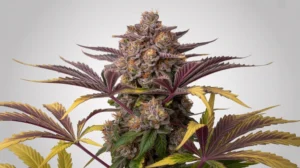Understanding Cannabis Genetics Terminology

Have you ever wondered how cannabis strains differ from one another? Why some strains have a sweet aroma, while others have a pungent smell? The answer lies in cannabis genetics. Understanding the genetic makeup of cannabis plants is crucial for breeders, growers, and consumers alike. By unraveling the mysteries of cannabis genetics terminology, you can gain insights into strain characteristics, potency, and effects.
In this article, we’ll explore the world of cannabis genetics terminology, and shed light on the language used in the field. From genotypes and phenotypes to hybrids and backcrossing, we’ll cover all the essential terms you need to know to understand cannabis genetics.
- Cannabis genetics refers to hereditary traits and characteristics found in different cannabis plants.
- Genetic factors influence the plant’s growth, potency, aroma, and overall effects, making it critical to understand cannabis genetics.
- Familiarizing yourself with common genetic terminology, such as genotype, phenotype, hybrid, and backcrossing, is essential for understanding cannabis genetics.
- Cannabis strains are often categorized based on their genetic makeup, including indica, sativa, and hybrid strains.
- Understanding phenotypes is essential for identifying and selecting desirable traits when breeding or growing cannabis.
What Is Cannabis Genetics?
When I first began exploring the world of cannabis, I was fascinated by the different strains and their unique characteristics. As I delved deeper, I learned about the role of genetics in the development of cannabis plants, and how they influence everything from growth to potency. Cannabis genetics refers to the hereditary traits and characteristics found in different cannabis plants. These genetic factors play a crucial role in the plant’s growth, development, potency, aroma, and overall effects.
Understanding the genetics of cannabis plants is key to developing new strains and identifying desirable traits. By studying cannabis genetics, breeders and enthusiasts can identify and develop unique strains with specific characteristics. The genetic makeup of a cannabis plant influences its morphology, effects, and overall appeal to growers and consumers.
You may be wondering, what exactly is a genetic trait? Simply put, a genetic trait is an inherited characteristic that is passed down from one generation to the next through DNA. When it comes to cannabis, genetic traits include everything from plant height to flower structure, terpene profile, and cannabinoid content.
As we explore the terminology and concepts of cannabis genetics, we’ll see how different genetic factors work together to create the diverse array of cannabis strains available today. So, let’s dive in and uncover the fascinating world of cannabis genetics!

Common Terminology
As you delve into the world of cannabis genetics, it’s essential to familiarize yourself with common genetic terms used in the industry. These terms will help you understand how different genetic elements contribute to the development of cannabis plants and their unique characteristics.
Here are some important genetic terms in cannabis:
| Term | Definition |
|---|---|
| Genotype | The genetic makeup of a plant, which determines its physical and chemical traits. |
| Phenotype | The observable traits and characteristics expressed by a plant, influenced by both genetic and environmental factors. |
| Hybrid | A combination of two different cannabis strains, which results in a plant with unique characteristics. |
| Backcrossing | A breeding technique used to retain desired traits of a parental strain in a new hybrid, by crossing it with one of its parent strains. |
| Allele | An alternative form of a gene that influences a specific trait, such as color or potency. |
| Terpene | A class of organic compounds responsible for the aroma and flavor of cannabis, which also possess medicinal properties. |
By understanding these terms, you will be able to better comprehend the different strains and their various effects. Whether you want to breed your own unique strains, or simply select the perfect strain for your needs, understanding these genetic terms is an essential first step.

Understanding Cannabis Genetics Terminology
Cannabis strains are often categorized based on their genetic makeup. The genetics of cannabis plants significantly influence their effects and characteristics, making it crucial for breeders and growers to understand the differences between strains.
There are three primary types of cannabis strains: indica, sativa, and hybrid. Indica strains are known for their relaxing effects, while sativa strains are associated with energizing and uplifting effects. Hybrid strains are a combination of both and can provide a balanced mix of effects.
Indica strains typically have wider leaves and a shorter stature, making them ideal for indoor growing. They also tend to have higher levels of CBD and lower levels of THC, making them an excellent choice for medical cannabis users seeking pain relief and relaxation.
Sativa strains, on the other hand, have narrow leaves and a taller stature, making them more suitable for outdoor growing. They often have higher levels of THC and lower levels of CBD, providing an energetic and cerebral high that can stimulate creativity and productivity.
Hybrid strains are a crossbreed of indica and sativa strains and can provide a mix of both types of effects. Breeders create hybrid strains to enhance specific traits and characteristics, resulting in a broad range of options for consumers to choose from.

Unraveling the Phenotype Puzzle
Phenotype refers to the observable traits and characteristics expressed by a cannabis plant, such as its height, leaf shape, and aroma. These traits are influenced by genetic factors, and understanding them is crucial for both growers and breeders looking to develop and select desirable plants.
Phenotypes are the result of the interaction between the plant’s genotype (its genetic makeup) and its environment. For example, a plant with genes for high THC content may only express that trait under specific growing conditions, such as a particular light cycle or nutrient regimen.
Identifying desirable phenotypes is an essential part of breeding new cannabis strains. Breeders will often select plants with desirable traits and cross them to create offspring that inherit those desirable characteristics.

The diversity of cannabis phenotypes is vast and can vary greatly between strains. Indica strains, for example, are typically shorter and bushier with wider leaves, while sativa strains tend to be taller and have thinner leaves.
Growers can also use phenotype selection to improve the quality and consistency of their cannabis crops. By selecting plants with desirable traits and propagating them through cloning or seed production, growers can ensure a more consistent crop with predictable characteristics.
The Role of Genetic Markers in Cannabis
Genetic markers are specific sequences of DNA that provide a unique fingerprint for each individual organism. In cannabis, genetic markers play a critical role in identifying and tracking genes that control various traits, such as potency, flavor, and aroma. By mapping the cannabis genome and identifying these genetic markers, researchers and breeders can gain a deeper understanding of the plant’s genetics.
One of the most significant applications of genetic markers is in cannabis genomics, which involves the comprehensive study of the plant’s DNA. This field combines genetics, bioinformatics, and other scientific disciplines to unravel the complex genomic structure of cannabis. By analyzing the cannabis genome, researchers can identify genetic markers that are associated with desirable traits and use this information to breed plants with specific characteristics.
Genetic markers in cannabis are also useful in tracking the lineage of cannabis strains. By analyzing genetic markers, researchers can determine the ancestry of a particular strain, including its geographic origin and genetic heritage. This information is essential for preserving the genetic diversity of cannabis and preventing the loss of rare or unique strains.
Overall, genetic markers are a fundamental tool for understanding the genetics of cannabis and unlocking its full potential. As research and innovation in cannabis genomics continue to progress, we can expect to see even more exciting developments in the field of cannabis genetics.

The Evolution of Cannabis Genetics
Looking back at the history of cannabis genetics, it’s clear that humans have played a significant role in shaping the traits and characteristics of the plant. Early on, cannabis evolved in diverse regions such as Central Asia and Africa, leading to a variety of landrace strains with unique genetic profiles.
However, as cannabis cultivation spread and prohibition took hold, many of these landrace strains were lost or hybridized with other strains. It wasn’t until the modern era of cannabis genetics that breeders began to focus on selectively breeding specific traits and developing new strains.
One of the most significant developments in cannabis genetics was the classification of strains into indica, sativa, and hybrid categories. Indica strains were thought to have originated in the Hindu Kush region of Afghanistan and were known for their relaxing, sedative effects. Sativa strains, on the other hand, were believed to have originated in equatorial regions and were known for their energizing, cerebral effects. Hybrids, as the name suggests, are a combination of the two.

Today, the cannabis genetics glossary continues to evolve as breeders experiment with crossbreeding, backcrossing, and other techniques to develop strains with specific characteristics. Some breeders also use advanced technologies such as genomics to identify specific genes responsible for desirable traits and create new strains with those characteristics.
The evolution of cannabis genetics has led to a vast array of strains and phenotypes with unique characteristics and effects. Understanding the historical and modern context of cannabis genetics can help growers and consumers appreciate the diversity of strains available today and make informed decisions about selecting and enjoying cannabis.
The Future of Cannabis Genetics
As the cannabis industry expands and legalization becomes more widespread, the potential for advancements in cannabis genetics grows. With technological developments such as genome sequencing and gene editing, the possibilities for enhancing the characteristics of cannabis strains are endless.
One of the most exciting areas of potential is personalized cannabis experiences. By analyzing an individual’s DNA, growers can create strains tailored to their specific needs and preferences. This could lead to a more targeted approach to medical marijuana and a more enjoyable recreational experience for consumers.
Another area of focus is sustainability. With the increasing demand for cannabis, breeders are exploring ways to create strains that are more resilient, resistant to pests and diseases, and require less water and nutrients. By utilizing genetic markers and targeted breeding, growers can create plants that are more environmentally friendly and cost-effective.
While there are certainly ethical and regulatory considerations surrounding genetic modification, the potential benefits of these technologies cannot be denied. As the industry evolves, so too will our understanding and utilization of cannabis genetics.

As the field of cannabis genetics continues to evolve, new technologies such as genome sequencing and genetic modification have the potential to further expand our understanding of this remarkable plant.
Ultimately, understanding and harnessing the power of cannabis strain genetics is key to unlocking the full potential of this versatile plant. Whether you’re a grower, breeder, or consumer, I encourage you to explore the fascinating world of cannabis genetics and discover all that this incredible plant has to offer.
Cannabis Genetics Terminology: Conclusion
I hope this article has served as a helpful guide to understanding cannabis genetics terminology. By gaining a deeper understanding of the genetic factors that influence the development of cannabis plants, you can make informed choices about strains and tailor your cannabis experiences to your preferences.
Remember that cannabis genetics terminology can be complex and challenging to navigate. However, armed with the knowledge provided in this article, you now have a foundation for exploring this fascinating field further.
Whether you’re a breeder, grower, or cannabis enthusiast, understanding cannabis genetics can unlock the full potential of this versatile plant. With advancements in technology and evolving regulations, the future of cannabis genetics is ripe with possibilities.
I encourage you to continue learning about cannabis genetics and exploring the diverse world of strains and phenotypes. Who knows, you might discover a new favorite strain or develop a groundbreaking hybrid that revolutionizes the industry.
FAQ
What is cannabis genetics?
Cannabis genetics refers to the hereditary traits and characteristics found in different cannabis plants. These genetic factors influence the plant’s growth, potency, aroma, and overall effects.
Why is understanding cannabis genetics important?
Understanding cannabis genetics allows breeders and enthusiasts to identify and develop unique strains with specific traits. It also helps consumers make informed choices based on the desired effects and characteristics of a particular strain.
What are some common genetic terms in cannabis?
Common genetic terms in cannabis include genotype, phenotype, hybrid, backcrossing, and more. These terms help explain the different genetic elements that contribute to the development of cannabis plants.
How are cannabis strains categorized?
Cannabis strains are often categorized as indica, sativa, or hybrid strains based on their genetic makeup. These genetic classifications influence the plant’s effects and characteristics.
What is a phenotype in cannabis?
Phenotype refers to the observable traits and characteristics expressed by a cannabis plant. Understanding phenotypes is essential for identifying and selecting desirable traits when breeding or growing cannabis.
What are genetic markers in cannabis?
Genetic markers are specific sequences of DNA that can be used to identify and track genetic traits. In the cannabis industry, genetic markers play a significant role in breeding programs and the development of new strains.
How has cannabis genetics evolved over time?
Cannabis genetics have evolved significantly over time due to human intervention and natural selection. From landrace strains to modern hybrids, understanding this evolution provides insight into the diversity of cannabis strains available today.
What does the future hold for cannabis genetics?
As cannabis legalization expands, the field of cannabis genetics is poised for exciting advancements. Emerging trends and technologies such as genome sequencing and genetic modification will shape the future of cannabis cultivation and consumption.
How can I harness the power of cannabis genetics?
Understanding cannabis genetics empowers breeders, growers, and consumers to make informed decisions. By leveraging genetics, you can choose strains, engage in targeted breeding, and personalize your cannabis experiences.
Suggested Articles
;)
;)
;)




 07 Jan 2026
07 Jan 2026  6 min read
6 min read


 October 09, 2023
October 09, 2023 


RESPONSES (0)
No responses yet. Be the first to respond!